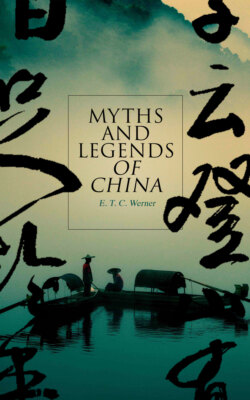Читать книгу Myths and Legends of China - E. T. C. Werner - Страница 18
На сайте Литреса книга снята с продажи.
Political History
ОглавлениеThe country inhabited by the Chinese on their arrival from the West was, as we saw, the district where the modern provinces of Shansi, Shensi, and Honan join. This they extended in an easterly direction to the shores of the Gulf of Chihli—a stretch of territory about 600 miles long by 300 broad. The population, as already stated, was between one and two millions. During the first two thousand years of their known history the boundaries of this region were not greatly enlarged, but beyond the more or less undefined borderland to the south were chou or colonies, nuclei of Chinese population, which continually increased in size through conquest of the neighbouring territory. In 221 B.C. all the feudal states into which this territory had been parcelled out, and which fought with one another, were subjugated and absorbed by the state of Ch'in, which in that year instituted the monarchical form of government—the form which obtained in China for the next twenty-one centuries.
Though the origin of the name 'China' has not yet been finally decided, the best authorities regard it as derived from the name of this feudal state of Ch'in.
Under this short-lived dynasty of Ch'in and the famous Han dynasty (221 B.C. to A.D. 221) which followed it, the Empire expanded until it embraced almost all the territory now known as China Proper (the Eighteen Provinces of Manchu times). To these were added in order between 194 B.C. and A.D. 1414: Corea, Sinkiang (the New Territory or Eastern Turkestan), Manchuria, Formosa, Tibet, and Mongolia—Formosa and Corea being annexed by Japan in 1895 and 1910 respectively. Numerous other extra-China countries and islands, acquired and lost during the long course of Chinese history (at one time, from 73 to 48 B.C., "all Asia from Japan to the Caspian Sea was tributary to the Middle Kingdom," i.e. China), it is not necessary to mention here. During the Southern Sung dynasty (1127–1280) the Tartars owned the northern half of China, as far down as the Yangtzu River, and in the Yüan dynasty (1280–1368) they conquered the whole country. During the period 1644–1912 it was in the possession of the Manchus. At present the five chief component peoples of China are represented in the striped national flag (from the top downward) by red (Manchus), yellow (Chinese), blue (Mongolians), white (Mohammedans), and black (Tibetans). This flag was adopted on the establishment of the Republic in 1912, and supplanted the triangular Dragon flag previously in use. By this time the population—which had varied considerably at different periods owing to war, famine, and pestilence—had increased to about 400,000,000.
